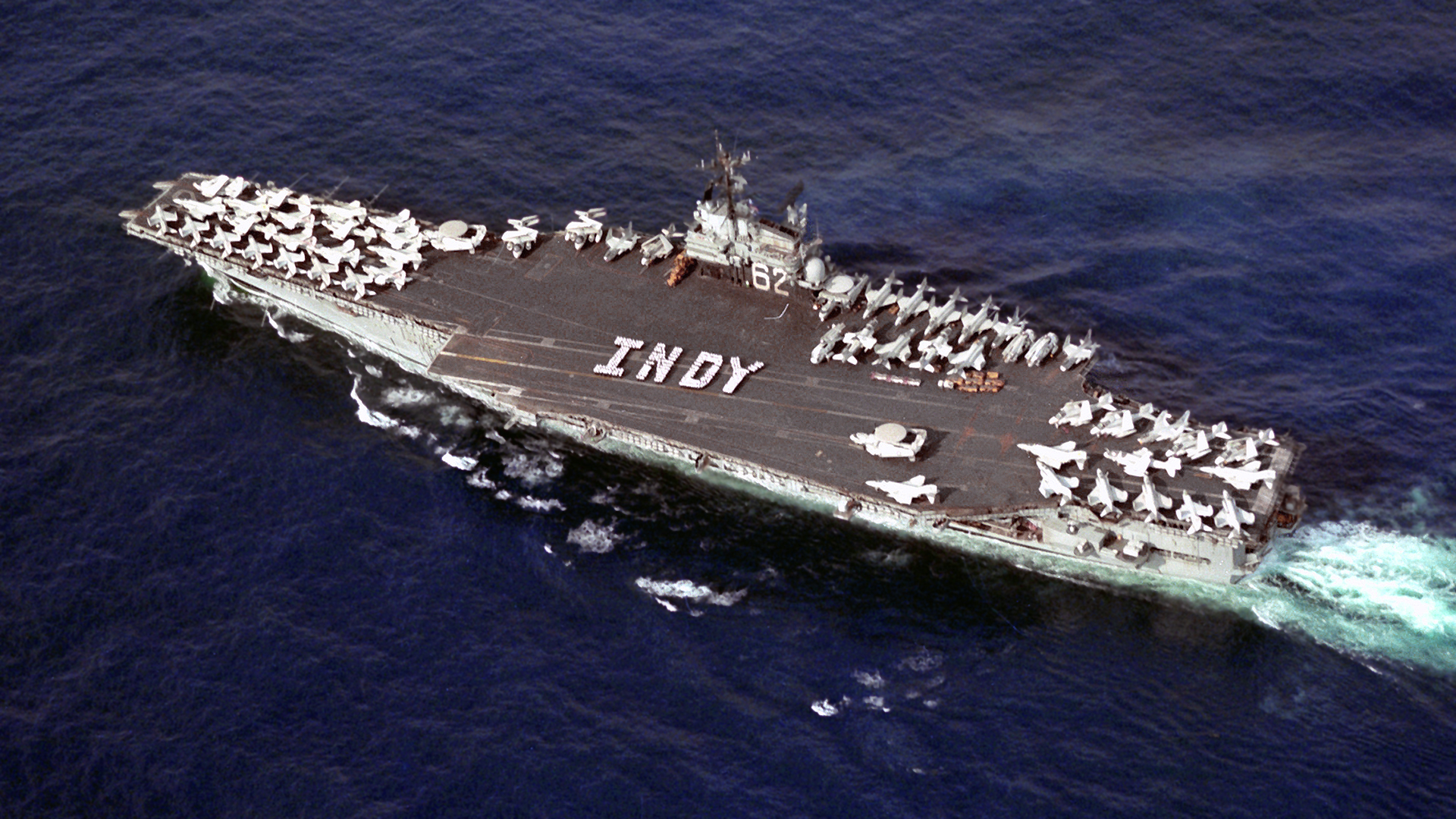Libertas Per Laborem Audentium. In English, ‘independence through bold action.’ That inscription last appeared on the crest of the U.S. Navy’s short-lived Littoral Combat Ship USS Independence (LCS-2), alongside the motif of the Liberty Bell. Together, these symbolize the freedoms won by America after gaining independence from the British, something recognized on this day, the Fourth of July, more than any other. But the most recent USS Independence, decommissioned just a year ago, was one among a long and illustrious line of ships of the same name, each of which commemorated this heritage as they propelled the Navy from the era of the Revolutionary War, to World War II, and all the way through to the more recent conflicts in the Middle East.
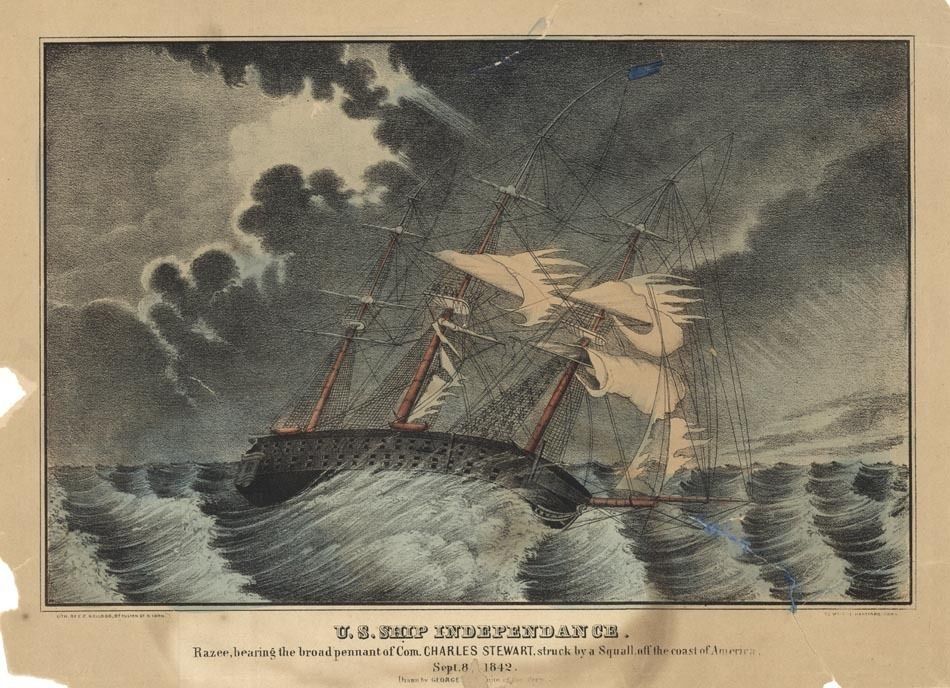
Brigantine Independence — the first of the many
Although less obvious, the aforementioned crest of LCS-2 also featured six merlons, a heraldic shape looking a little like a battlement. Each of these represented the previous ships to bear the name Independence. The first of these was a brigantine, a two-masted sailing vessel with at least two sails on the main mast. The brigantine was one of the most popular types of warships in the British colonies and was something of a multi-purpose vessel of its day. Faster and more maneuverable than a sloop or schooner, brigantines were used for reconnaissance, for protection of larger vessels, supply, and even piracy.
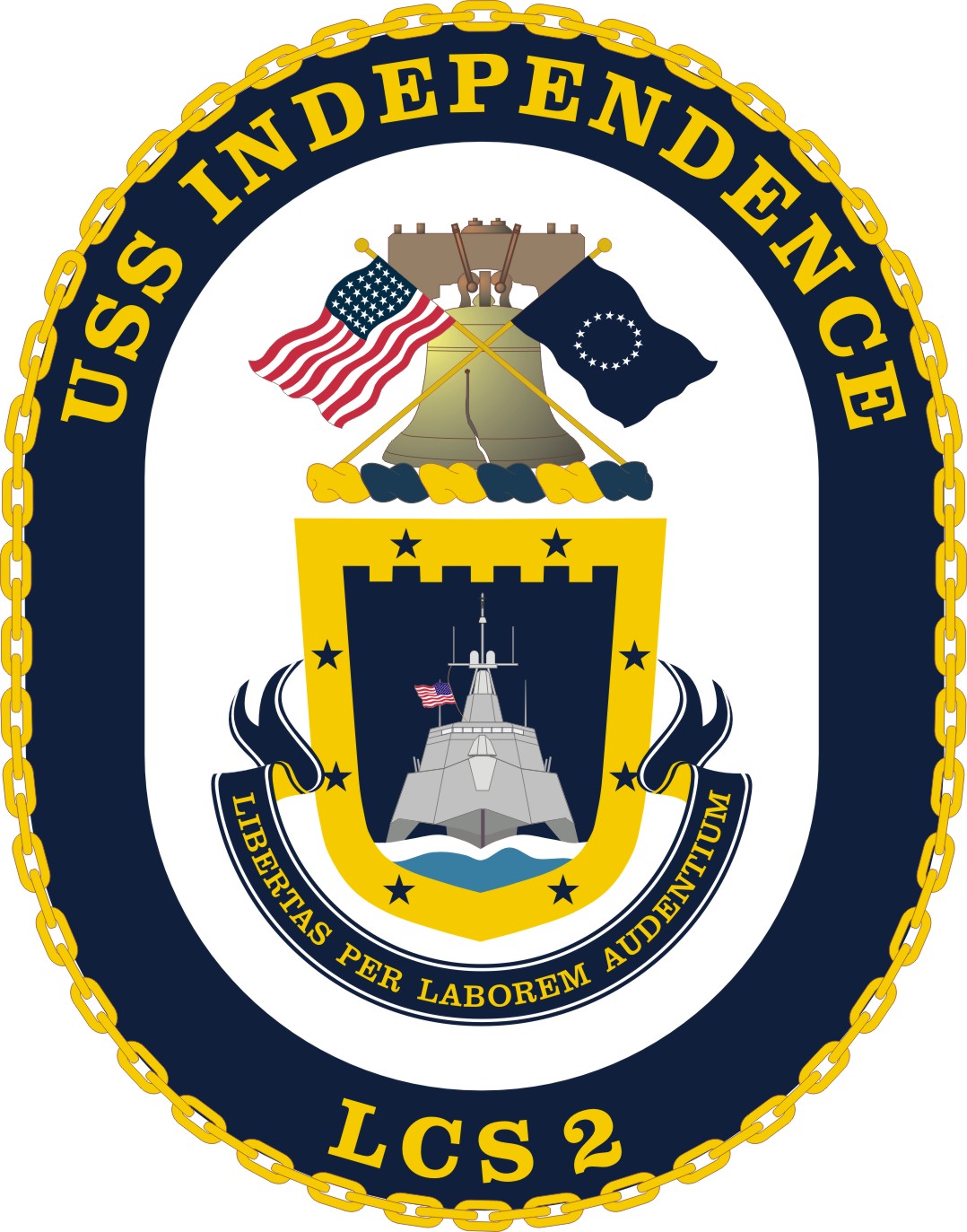
As for Independence, this was built at Kingston, Massachusetts in mid-1776, being completed just days after the Declaration of Independence. The brigantine served in the recently established Massachusetts Naval Militia, as one of that service’s first three ships. The militia was set up to defend the state’s interests during the Revolutionary War and, at times, it fought alongside the Continental Navy, the French, and privateers.
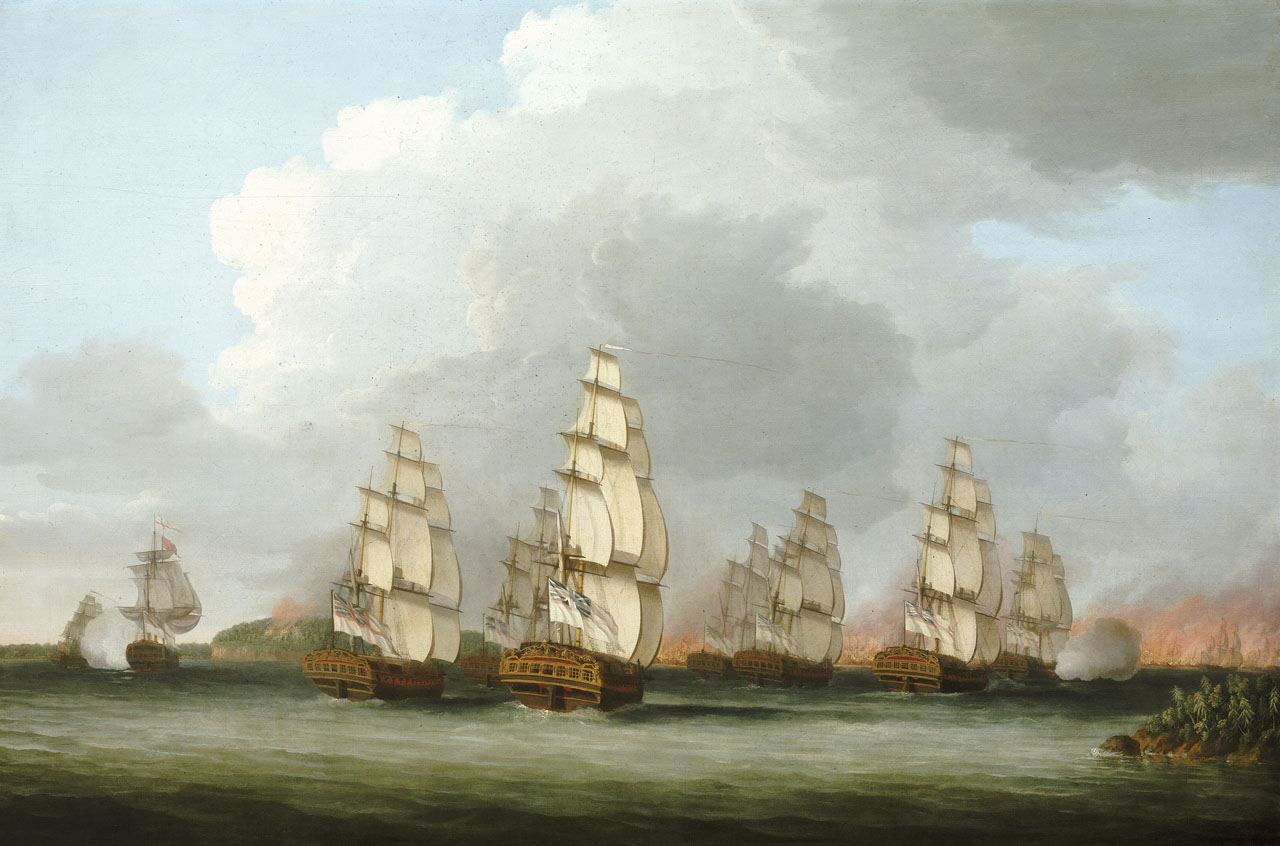
However, the 16-gun vessel was destined to have only a very short career, spent primarily off the coast of New England. In July 1776, the following message was sent to Capt. Simeon Sampson of the Independence:
“Directed Imediately to proceed on a Cruize not only against our Unatural Enemies, but also for ye Protection of the Trade of the United States, and you are directed to Range the Coast of the Province of Main … and from thence proceed as farr Southward as the Lattitude thirty-four North, and not further West than the Shoals of Nantuckett, nor further East than the Island [of] Sable, on the Coast of Nova Scotia.”
In November of the same year, the Independence — together with Capt. Sampson — was captured by the Royal Navy, after a clash with HMS Hope, a 14-gun brig, another two-mast ship of a different configuration.
Although Independence had a larger crew and heavier armament, skillful sailing by the crew of the Hope saw the American vessel taken intact. It was then escorted to Fort Cumberland, in what is now New Brunswick, Canada, where 14 of its guns were used to bolster the fort’s defenses.
It was an inauspicious end to the career of the Massachusetts Naval Militia brigantine, but the Revolutionary War was far from over, and the Independence name would appear again before long.
Sloop Independence — revolutionary messenger
Typically styled USS Independence, in contrast to its predecessor, but that suffix was only formally adopted in 1907 to identify a commissioned ship of the Navy. Nevertheless, this 10-gun sloop, built in Baltimore, Maryland, and commissioned in September 1776, is sometimes referred to as the first ship to carry the name, although this is specifically contradicted by the Pacific Fleet.
At the time of its commissioning, the sloop, a type that features a single mast, was the most popular vessel in America’s British colonies. Assigned to the Continental Navy, the USS Independence, while short-lived, would, however, play a prominent role in the Revolutionary War. The Continental Navy had been established to intercept shipments of British matériel and play havoc among British maritime commerce, starting off with converted merchantmen before fielding purpose-designed vessels.
Before the end of 1776, the USS Independence had voyaged to the Caribbean Sea to protect American merchant trade in the West Indies, and to raid British shipping when the opportunity arose.
While the Continental Navy’s successes in the war were relatively limited, USS Independence achieved fame when chosen to serve as a dispatch boat — a vessel used to deliver messages or mail. In this capacity, the sloop sailed to France in 1777, and there embarked the naval commander John Paul Jones, often described as the ‘Father of the American Navy,’ at the end of his diplomatic mission there.
The presence of the Independence in France saw the sloop sail with the French fleet, receiving a nine-gun salute that was one of the first examples of official recognition of the fledgling American government. In early 1778, soon after the signing of the Treaty of Alliance, the Independence was off the coast of France, when the sloop-of-war Ranger, now with John Paul Jones aboard, received the first national salute to the flag. This was the first official recognition of the American Republic by a foreign power.

Jones was back onboard Independence for the return across the Atlantic, but in April 1778 the vessel hit a sand bar in the Outer Banks, North Carolina. The sloop could not be recovered, although its guns, cargo, and ship’s bell were all salvaged.
Ship-of-the-line Independence — well-traveled warrior
By the time the three-masted USS Independence was launched in the Boston Navy Yard in June 1814, the revolutionary-era Continental Navy had been effectively disbanded and superseded by the U.S. Navy. The Independence was that service’s first ship of the line, a type of sailing warship intended to be used in line-of-battle tactics, in which a column of ships fired cannons from their broadsides.
Ships of the line relied on their weight of fire for success and their design stressed as many heavy guns as possible. In the case of the Independence, this originally amounted to 90 guns.

When commissioned, the Independence was blockaded in port by the Royal Navy, then engaged with the U.S. Navy in the War of 1812 (which lasted until 1815). In July 1815, Independence set sail for North Africa as part of a squadron tasked with finally defeating the Barbary Coast Pirates, a mission that was very quickly successful, with the signing of a peace agreement.

After a period in reserve, the Independence was reworked, emerging in 1837 with its upper deck removed and a reduced armament of 54 guns. Although classed as a frigate, the Independence was larger and faster than most of those ships. This made it suitable for long-range work, including a visit to Russia, before heading from there to Rio de Janeiro, where it headed up the Brazil Squadron, protecting U.S. commerce in South America.

Another period in reserve followed, then service with the Home Squadron off the U.S. eastern seaboard, before recommissioning in 1846, in time for the Mexican War. Off the California coast, the Independence was now the flagship of the Pacific Squadron, enforcing a blockade of the Mexican coast, including the capture of several Mexican ships. The ship participated in the capture of the city of Guaymas and landed Marines during the occupation of Mazatlán.
Decommissioned at Norfolk, Virginia, in 1849, the Independence was soon recommissioned for service in the Mediterranean and then in the Pacific. From 1857, it served as a receiving ship, accommodating new naval recruits, before being decommissioned for the last time at Mare Island Navy Yard, California, in 1912.

The hulk of the Independence was finally burnt in 1915, on the mudflats at Hunters Point, San Francisco.
The Navy’s various Independences have not always been as warlike as ships of the line, however.
Attack transport Independence — two World Wars, three names
The next Independence carried the name for only a brief portion of its naval career and is, therefore, better remembered today as the USS Neville.
This steamer was originally ordered from Bethlehem Steel Company, Alameda, California, as the SS War Harbour, to serve as a British merchantman. World War I intervened, however, and the hull was completed for the U.S. Navy, and the USS Independence (SP-3676) was commissioned into service in November 1918. Wartime service included one transatlantic crossing, bringing foodstuffs to the United Kingdom.
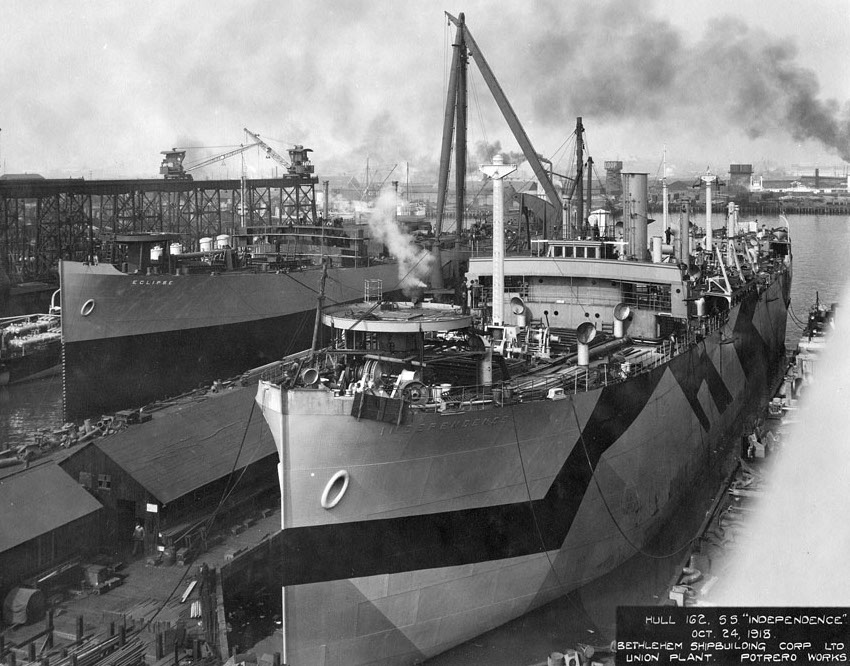
After World War I, the Navy no longer had use for the Independence and the vessel returned to civilian duties with the U.S. Merchant Marine, as the City of Norfolk.
With the world at war again, the Navy recommissioned the vessel in May 1941 as USS Neville (AP-16), part of the Heywood class of attack transports — essentially, troopships optimized for moving soldiers as part of an invasion force, the precursors to today’s landing platform, amphibious (LPA) ships.

Initial duties for the Neville after the U.S. entry to the war included landing exercises along the Virginia coast and a transatlantic voyage transporting personnel to the United Kingdom.
The Neville entered the Pacific Theater during the assault on Guadalcanal, offloading troops onto landing boats to help kick off the campaign in the Solomons.

Redesignated APA-9, the Neville took part in the invasion of Sicily in the summer of 1943, before returning to the Gilbert and Marshall Islands in the Pacific Theater. The assault transport was also involved in the campaign in the Marianas.
Final decommissioning for this World War I-era transport came in April 1946, followed by scrapping in 1957.
Throughout its World War II service, the Neville received five battle stars — the next Independence would be decorated with no fewer than eight in the same conflict.
Light aircraft carrier Independence — Pacific Theater survivor
The Independence name is today perhaps best associated with aircraft carriers, the first of which was the lead ship of its class, a light aircraft carrier, one of three converted from the hulls of Cleveland class light cruisers.
Built by the New York Shipbuilding Corporation, Camden, New Jersey, on the basis of the incomplete light cruiser Amsterdam, USS Independence (CV-22) was commissioned in January 1943 and by July that year was at Pearl Harbor, preparing to join the war in the Pacific.

Its first action was a raid on Marcus Island in September 1943, together with the carriers Essex and Yorktown, with another strike against Wake Island in October, by which time Independence had been redesignated as CVL-22.
In November 1943, it was time for strikes on Rabaul and the Gilbert Islands, with the Rabaul action including six Japanese aircraft claimed downed by the carrier’s anti-aircraft guns. During pre-landing strikes against Tarawa during November 18-20, Independence came under aircraft attack again, this time a torpedo striking the vessel’s starboard quarter. Badly damaged, the carrier limped back to San Francisco for repairs between January and July 1944.
Following repairs, Independence embarked specialist night-fighter and night torpedo bomber units and was back in action in August 1944, now striking numerous targets in Luzon in the Philippines and then Okinawa. The carrier took part in the Battle of Leyte Gulf in October, which inflicted heavy losses on the Japanese Mobile Fleet, including four Japanese carriers and the battleship Musashi, which aircraft from Independence helped sink. Independence also played a critical role in finding and then shadowing the Japanese carrier group under Admiral Ozawa, doing so using its night-capable squadrons.

With the Imperial Japanese Navy now no longer an effective fighting force, the Independence saw out the war with further raids on targets in the Philippines as well as the final carrier strikes against Japan.
Eight battle stars were not enough to protect the Independence in the nuclear age, however, and the carrier was earmarked for the Operation Crossroads atomic bomb tests in July 1946. Despite the detonation of two 23-kiloton nuclear bombs only half a mile away, the Independence refused to sink. After examination, the highly radioactive hull was sunk off the coast of California, using a pair of torpedoes, in January 1951.

Aircraft carrier Independence — Cold War supercarrier
Another carrier, USS Independence (CV-62) was the fourth and final member of the Forrestal class, built at Brooklyn Navy Yard and commissioned in January 1959. While conventionally powered, the Forrestals were frequently, if unofficially, dubbed ‘supercarriers,’ each with a fully loaded displacement of 78,000 tons and a flight deck large enough to operate the A3D Skywarrior nuclear bomber, as part of an air wing of roughly 90 aircraft.

The early part of its operational career saw the ‘Indy’ frequently active in the Mediterranean, starting with its first cruise in 1960. The Cuban Missile Crisis in October 1962 saw the carrier underway in the Caribbean Sea, as part of the naval blockade of the island.
In May 1965, Independence began a deployment lasting more than seven months off the coast of Vietnam, where activities included taking part in major strikes against supply lines in North Vietnam, with more than 7,000 sorties launched in the face of fearsome surface-to-air missile defenses.

In the early 1980s, the Independence supported the multinational peacekeeping force in Lebanon, followed by the U.S. invasion of Grenada, for which it provided the core of the carrier task group. There followed a Service Life Extension Program (SLEP), which was designed to keep the carrier in service into the 1990s, and in this configuration the ‘Indy’ arrived in the Gulf of Oman in August 1990, to respond to the Iraqi invasion of Kuwait. The carrier began the longstanding presence of carriers in the Persian Gulf but was back in the United States before Operation Desert Storm began in early 1991.

After a period spent as the forward-deployed carrier at Yokosuka, Japan, the Independence was back in the Gulf in August 1992 and its aircraft were among the very first to help enforce the no-fly zone under Operation Southern Watch.
Additional Southern Watch deployments followed before the Independence was relieved at Yokosuka by USS Kitty Hawk and was then decommissioned in Bremerton, Washington, in September 1998. This ended 39 years of active service, although the carrier was only struck off charge in 2004 and it wasn’t until 2019 that the process of scrapping was completed. Some parts of the carrier were recycled, to support the remaining Kitty Hawk class as well as to be used on later Nimitz class vessels.

Littoral Combat Ship USS Independence — last of the line?
Long before the scrapper’s torch had finished its work on the aircraft carrier Independence, a successor to the name entered service, when USS Independence (LCS-2) was commissioned in 2010. Ironically, however, the same warship would be decommissioned just two years after the final demise of its carrier namesake — in 2021.
The first of the Independence subclass of Littoral Combat Ships, USS Independence, was introduced to great fanfare, with the expectation that these vessels would be able ability to fulfill numerous roles, including neutralizing small boats, quiet diesel-electric submarines, and locating mine threats, as true multi-role platforms.

As it turned out, however, the LCSs of both the Independence and Freedom subclasses have had a catalog of problems that’s reduced their operational capability — and relevance — significantly. In the meantime, the mission package concept, which the warships would have relied upon to conduct the planned broad spectrum of missions, has been abandoned. Instead, the surviving ships will get a single mission package installed permanently, although the anti-submarine capability has been abandoned altogether.
And, despite some of the progress the Navy has made in expanding the capabilities of its Independence class LCSs, including deployments in the Pacific region, more recently it became apparent that the entire fleet was experiencing cracking issues that may impose limits on how and where they can operate.

This sorry state of affairs, coupled with the fact that these warships, which were supposed to be relatively cheap, cost nearly as much to operate as a far more capable Arleigh Burke class destroyer, had led to the Navy campaigning to get rid of at least a portion of the LCS fleet.
The first of these warships to go was the USS Independence that was decommissioned in July last year, a little more than a third of the way into a planned 30-year career. Perhaps not surprisingly, the decommissioning ceremony was a low-key affair. Since then, USS Freedom (LCS-1), has also retired, although plans to decommission nine of the Freedom subclass could still be scaled back.
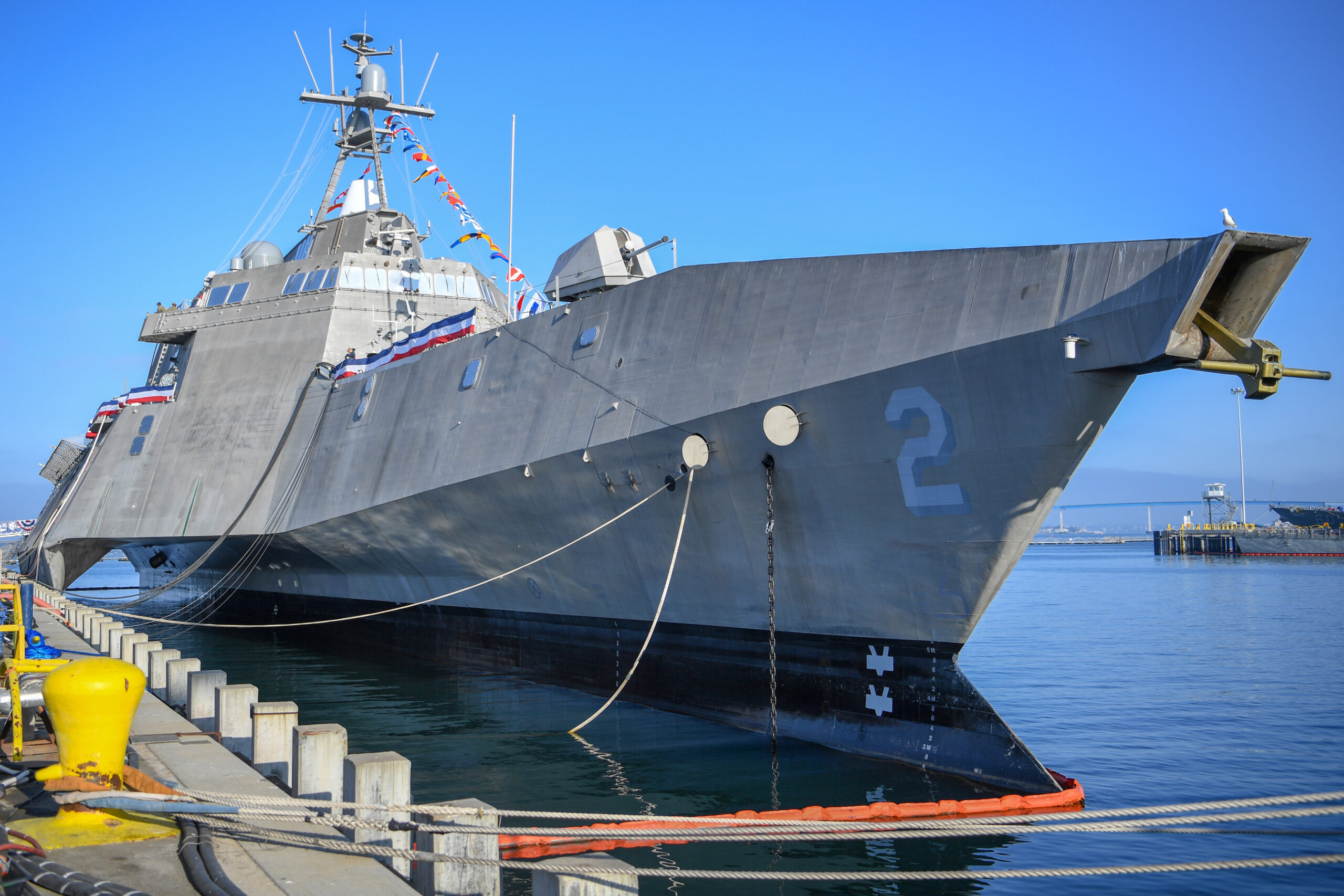
As it stands now, whatever the future brings for the remainder of the LCS fleet, the USS Independence (LCS-2) hardly came close to matching any of the many achievements of its historic namesakes. But given what this famous name means, and its close bond with America gaining national independence, it would not be a surprise for the name to be resurrected again in years to come.
Contact the author: thomas@thedrive.com
